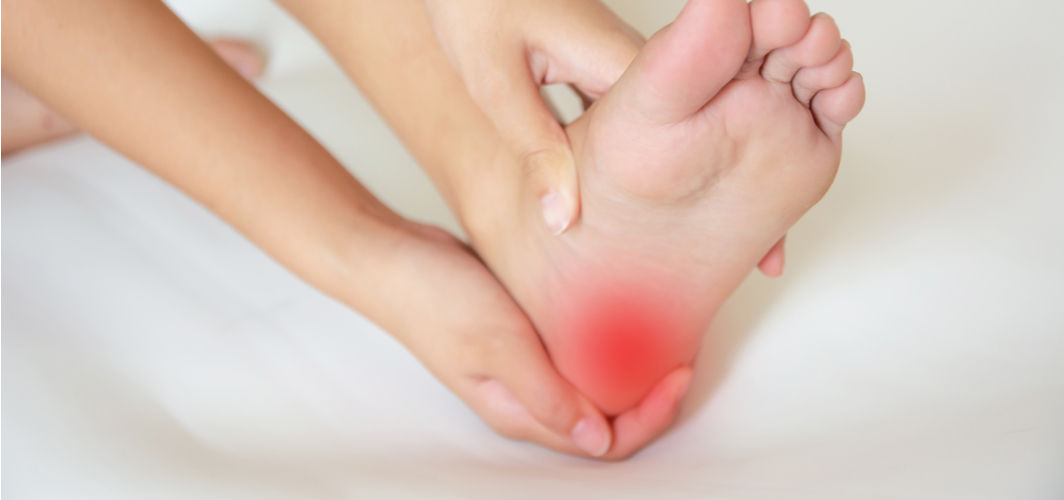Orthopedic Conditions
Plantar Fasciitis: Managing Persistent Heel Pain
4 min read
By Apollo 24/7, Published on - 19 October 2021, Updated on - 18 October 2022
Share this article
1
2 likes

Many adults, especially those over the age of 50 years, can sometimes experience some form of pain in the feet. If the pain is persistent and is felt mainly at the heel, it may indicate an inflammatory condition called plantar fasciitis. The plantar fascia is a long, thick band of tissue that lies at the bottom of the feet and connects the heel bone to the toes while creating an arch. Plantar fasciitis is the inflammation of the plantar fascia and is characterized by continuous heel pain. It can also be associated with a heel spur, an outgrowth from the heel bone.
What are the symptoms of plantar fasciitis?
Symptoms of plantar fasciitis may vary for every person; while some may experience dull pain, others may complain of stabbing pain. Some of the common symptoms include:
- Pain, stiffness and burning sensation in the bottom of the heel that lasts for months
- The pain either develops slowly with time or starts suddenly after intense activity
- Pain aggravates after exercising, climbing stairs or after standing or sitting for long
- Pain in the arch of the foot
- Swelling in the heels
- Pain that gets severe in the morning.
What causes plantar fasciitis?
There is no single cause for plantar fasciitis. Factors that may strain the plantar fascia and cause heel pain include:
- Being overweight
- Standing for a prolonged period
- Overstretching the sole while exercising
- Having a stiff Achilles tendon (a band of tissue that connects the calf muscles to the heel bone)
- Carrying heavy weights
- Sudden change in physical activity such as running frequently or for long hours
- Wearing high-heels or footwear with poor cushioning that does not support the arch of the foot
- Injury while doing any jumping activity
- Development of a heel spur.
Sometimes people suffering from autoimmune diseases such as lupus or rheumatoid arthritis can also develop plantar fasciitis.
Can plantar fasciitis be treated?
Most people with plantar fasciitis see an improvement in their symptoms within 10 months of starting simple treatment options which include:
- Cold compressions: Cold compressions on the sore heels using ice packs for at least 20 minutes, several times a day can help in relieving pain and inflammation.
- Medications: Doctors may prescribe some nonsteroidal anti-inflammatory medications such as ibuprofen to reduce pain.
- Physical therapy: Stretching is the best non-invasive treatment for plantar fasciitis. Physical therapists may help the patient learn stretching exercises such as calf stretching with leg swing, plantar fascia, toe flexion and standing soleus stretching that can be practised several times a day to strengthen the lower leg muscles and stabilize the ankle.
- Steroid injection: Doctors may recommend corticosteroid injections to patients who do not respond well to physical therapy. These injections are administered in the plantar fascia to reduce inflammation.
- Shock wave therapy: In this therapy, low or high-energy shock waves are delivered to the sore region of the heel to trigger a healing response in the plantar fascia.
- Surgery: Surgery is needed in severe cases and is aimed at lengthening the gastroc tendon, a part of the Achilles tendon. This surgery helps by reducing pain and allowing proper movement of the foot.
Lifestyle modifications for managing plantar fasciitis at home
Some lifestyle changes that may help manage plantar fasciitis at home include:
- Taking adequate rest and icing the feet when the muscles feel sore.
- Stretching the feet, calves, and the Achilles tendon every morning, before and after exercising.
- Practising exercises such as calf lifts and weight-bearing lunges to strengthen the calf muscles and to avoid the strain encountered during strenuous workouts. Increase the level of exercise/activity gradually to avoid straining the feet.
- Consuming a protein-rich diet by adding lean meat, lentils, soybean and eggs. Reducing the consumption of carbohydrates and saturated fats (present in processed foods) to maintain a healthy weight is recommended.
- Avoiding standing or sitting in the same position for long hours.
- Wearing properly cushioned shoes with a low heel. If needed, add soft insoles or heel pads inside the shoes.
- Avoiding exercises such as jumping or running and instead opting for swimming or cycling as they do not put pressure on the feet.
- Wearing night splints to stretch the foot while sleeping.
Conclusion
Plantar fasciitis is a common cause of heel pain that can develop due to overstretching, different anatomy of the foot or a medical condition. The condition is characterised by severe, persistent pain around the heel and arch of the foot which intensifies on exercising, running or even prolonged standing. Most cases of plantar fasciitis can be managed by icing, stretching, and medications. People experiencing continuous pain in the heel should contact an orthopaedic doctor for further evaluation.
Orthopedic Conditions
Leave Comment
Recommended for you

Orthopedic Conditions
Here’s What You Need To Eat To Maintain Your Bone Health
Proper nutrition is required to build healthy bones and maintain them throughout life. Read to know the ways to achieve proper bone health.

Orthopedic Conditions
Don’t Ignore Your Back Pain! It Can Be Sciatica
Consistent back pain can be a sign of sciatica. Read to know the ways to prevent it.

Orthopedic Conditions
Is Poor Sleep Related To Lower Back Pain? Know What Science Says
Poor sleep and lower back pain are related. To ease your lower back pain, you need to invest in a supportive mattress, practice good sleep habits, and exercise regularly. Get the rest you need and relieve lower back pain.
Subscribe
Sign up for our free Health Library Daily Newsletter
Get doctor-approved health tips, news, and more.
Visual Stories

10 Foods That Are Unhealthy for Your Bones
Tap to continue exploring
Recommended for you

Orthopedic Conditions
Here’s What You Need To Eat To Maintain Your Bone Health
Proper nutrition is required to build healthy bones and maintain them throughout life. Read to know the ways to achieve proper bone health.

Orthopedic Conditions
Don’t Ignore Your Back Pain! It Can Be Sciatica
Consistent back pain can be a sign of sciatica. Read to know the ways to prevent it.

Orthopedic Conditions
Is Poor Sleep Related To Lower Back Pain? Know What Science Says
Poor sleep and lower back pain are related. To ease your lower back pain, you need to invest in a supportive mattress, practice good sleep habits, and exercise regularly. Get the rest you need and relieve lower back pain.